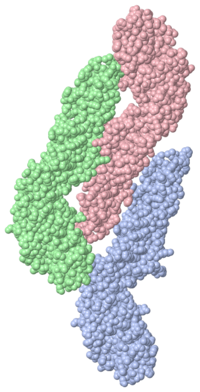When the virus is in its infectious form the surface is smooth, but as it is exposed to the acidic environment of the cell causes the proteins to snap into a trimeric spike so as to penetrate and then fuze with the lysozome membrane.
After the lysozome membrane has been penetrated the RNA is injected and the infection begins
After a person is infected with dengue, they develop an immune response that produces specific antibodies that prevent the virus from binding to macrophage cells and gaining entry.
However, if another subtype of dengue virus infects the individual, the virus will activate the immune system to attack it as if it was the first subtype, producing the same antibodies as before, unfortunately these do not work on the subtype.
The immune system is tricked because the four subtypes have very similar surface antigens. The antibodies bind to the surface proteins but do not inactivate the virus.
The human body is dependant on the right antibody response, and because it is not the right response the virus is not inactivated.
The immune response attracts numerous macrophages and the virus proceeds to infect them.
This makes the viral infection much more acute, and the body begins to release cytokines (small cell-signaling protein molecules that are secreted by the glial cells of the nervous system) which causes the endothelial tissues (the layer of cells lining the interior surface of all blood vessels, from the heart to the smallest capillary) to become permeable, it then turns into Dengue Haemorrhagic Fever, which is deadly.
In the infectious form of the virus, the envelope protein lays flat on the surface of the virus, forming a smooth coat with icosahedral symmetry. However, when the virus is carried into the cell and into lysozomes, the acidic environment causes the protein to snap into a different shape, assembling into trimeric spike, as shown at the bottom from PDB entry 1ok8. Several hydrophobic amino acids at the tip of this spike, colored bright red here, insert into the lysozomal membrane and cause the virus membrane to fuse with lysozome. This releases the RNA into the cell and infection starts. The hemagglutinin protein on the surface of influenza virus plays a similar role, but the two proteins use entirely different mechanisms to perform a similar task.


